Mining Project in Northwoods Worries Opponents
Explorative effort the first in nearly 30 years. Faces tribal lawsuit, other opposition.
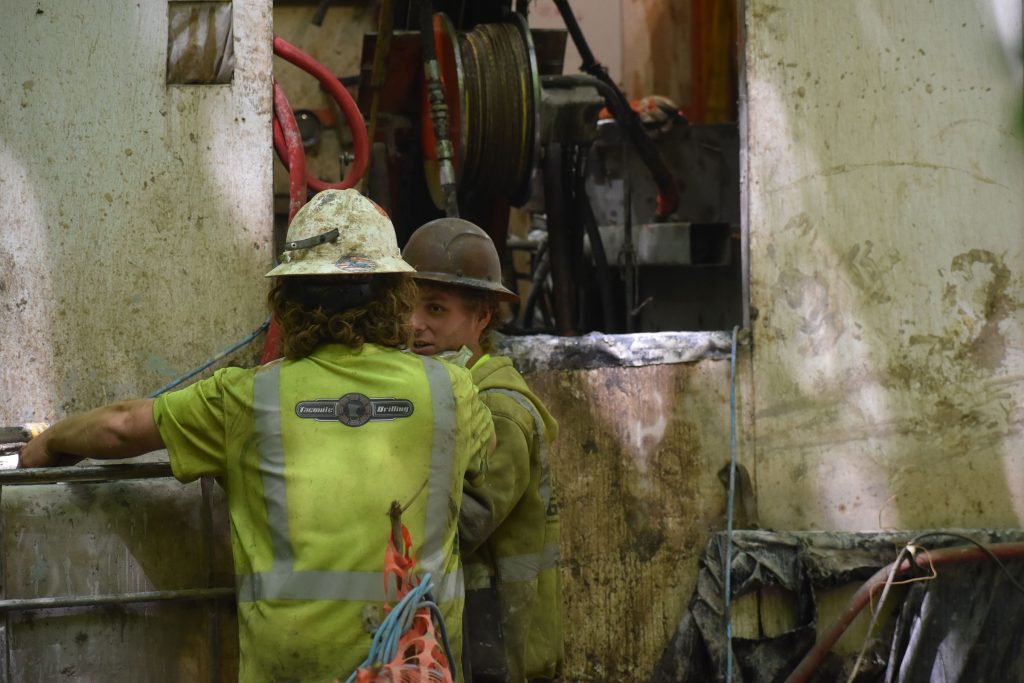
Crews worked to abandon or seal a hole drilled as part of a mining company’s exploration of the Bend deposit in the Chequamegon-Nicolet National Forest on July 17, 2025. Danielle Kaeding/WPR
Just off a gravel road, heavy mats cover mud and wet soil on an access route to the site where mining company Green Light Wisconsin has just finished drilling a hole to explore for copper and gold in the Chequamegon-Nicolet National Forest.
In the woods, a backhoe and a skid-steer are visible and a water truck is parked in front of a drill rig. For late July, the air is relatively cool and thick with mosquitoes from recent rains.
Deep beneath the surface, company officials hope cores of bedrock they’ve collected will show evidence of rare metals at the Bend deposit in Taylor County. It’s believed to contain around 4.2 million tons of copper and gold.
Steve Donohue, a director on the company’s board, said Green Light is expanding exploration for not only copper and gold, but also tellurium. The rare metalloid is used in electronics and in the manufacture of solar panels. Donohue said those metals are key for domestic energy production and the clean energy transition.
Even so, he said the company is in the early stages of exploration.
“We’re not at a stage where we’re looking at developing a mine. It’s just proving out the resource,” Donohue said. “Other things we will be looking at are other leases and other sites within the northern part of the state.”
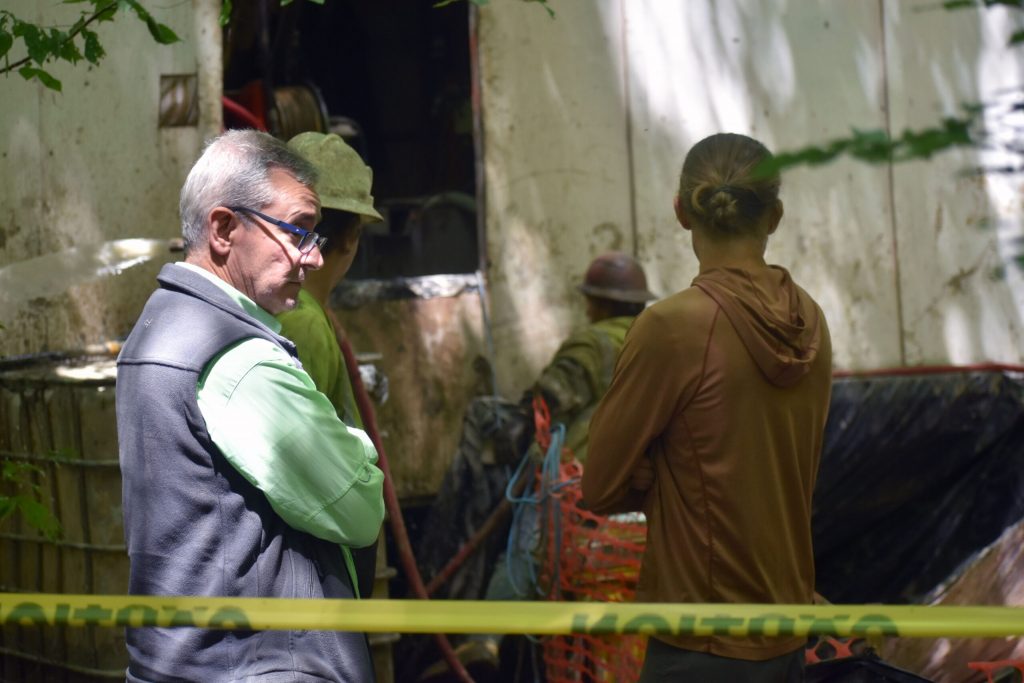
Steve Donohue, a director on the mining company’s board, observes activities at a drill site in the Chequamegon-Nicolet National Forest on July 17, 2025. Danielle Kaeding/WPR
Exploration for metallic mines is fairly rare. This project is the first activity in Wisconsin since a company drilled for zinc, copper and gold in Oneida County five years ago. In 2011, mining company Gogebic Taconite announced controversial plans to build a $1.5 billion iron ore mine in northern Wisconsin, but it abandoned the project four years later.
Metals like gold and copper that occur in sulfide minerals haven’t been mined in Wisconsin since the Flambeau mine shut down in 1997. That mine served as a catalyst for the state’s sulfide mining moratorium signed into law by Republican former Gov. Tommy Thompson. In 2017, that moratorium was repealed under a law passed by the Republican-controlled state Legislature and signed by GOP Gov. Scott Walker. The changes paved the way for mining sulfide ore bodies, which environmentalists and tribes fear will lead to water contamination.
Green Light Wisconsin plans to drill for metals like gold and copper at several other deposits in Marathon, Oneida and Jackson counties. As drilling is ongoing, Wisconsin tribes and environmental groups have voiced concerns about the potential effects to groundwater, wetlands and cultural sites.
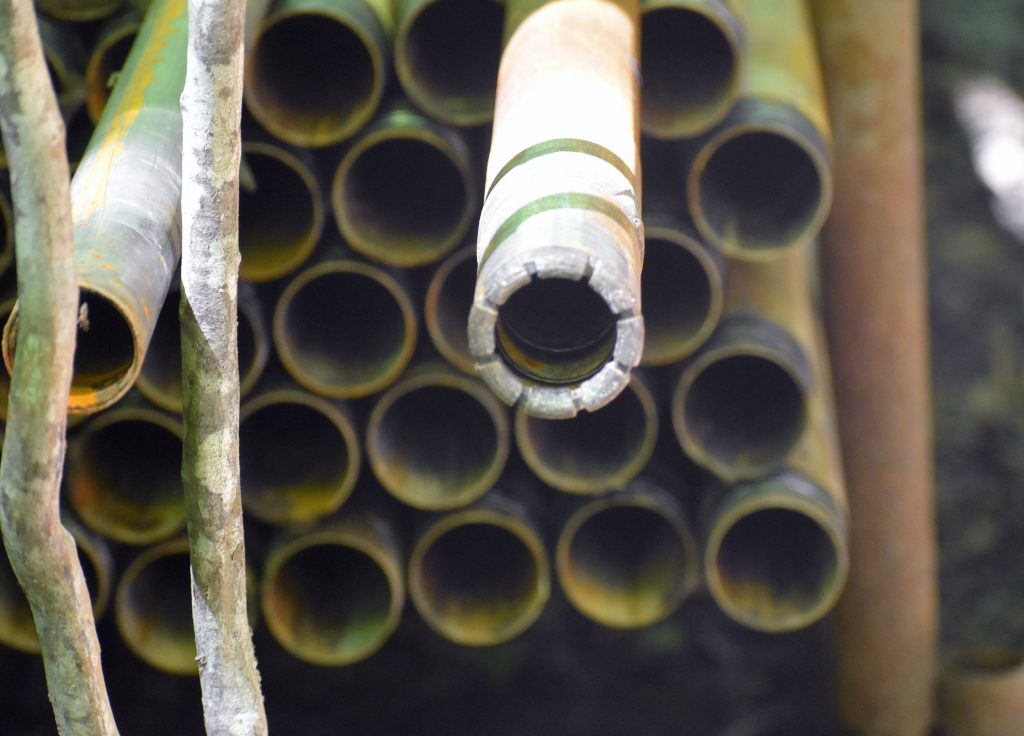
A diamond-core drill bit is used to bore through glacial material and bedrock as Green Light Wisconsin explores the Bend deposit for copper and gold. Danielle Kaeding/WPR
What’s involved in the drilling process?
Crews began drilling in late June on less than an acre of land near the North Fork of the Yellow River. Green Light is leasing mineral rights from the Soo Line Railroad to explore a 40-acre parcel.
Then a core tube is set within the rods right above the hollow drill bit. As drilling advances, the core is fed up into the tube. When it’s full, the core is retrieved through a wireline tool and brought to the surface and emptied into core boxes.
As of mid-July, crews had drilled holes that extended between 900 and 1,000 feet deep. Near the drill rig is a pit with a plastic liner that’s used to collect drill cuttings and water, called a sump. That water is reused during the drilling process.
“They pump (drilling water) down to the drill bit,” said Eric Quigley, director of exploration for Green Light. “They use it to cool and lubricate the drill bit, and to flush those cuttings out to the top of the casing.”
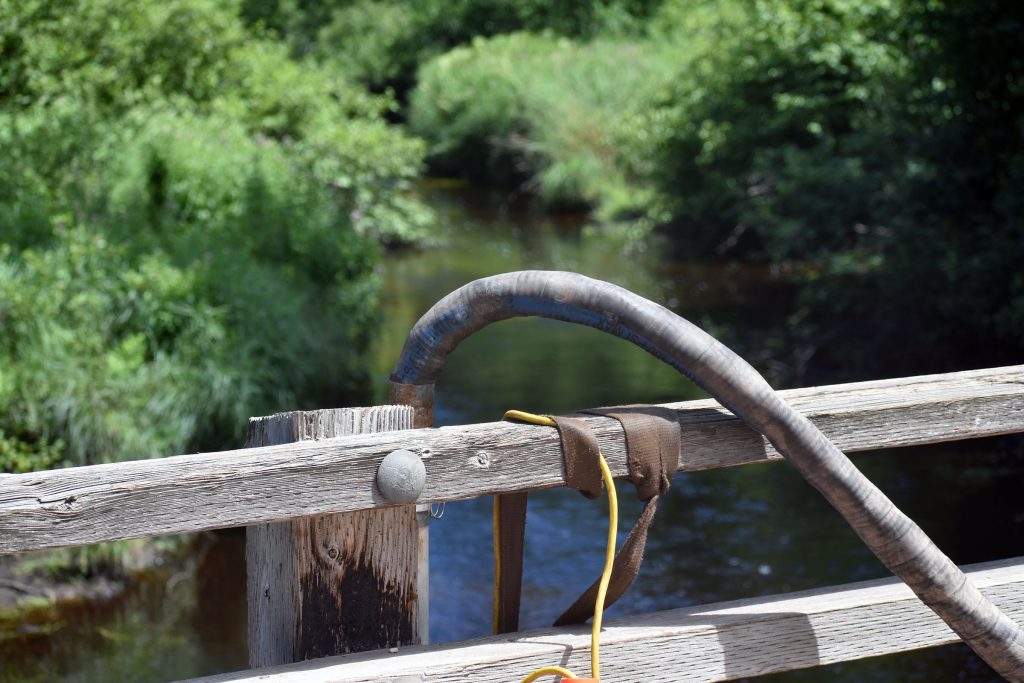
The drilling contractor for Green Light Wisconsin has been pumping around 1,500 gallons daily as part of drilling operations at the Bend deposit in the Chequamegon-Nicolet National Forest near Medford. Danielle Kaeding/WPR
About 600 feet down the road, an intake pipe runs from a bridge down to the North Fork of the Yellow River. Crews have pumped around 1,500 gallons of river water daily for drilling when they’re not using rainwater. It’s treated with chlorine to avoid introducing any organisms into the groundwater.
“They’re supposed to be mining gold out here,” Shaw said, pulling up alongside company officials.
Shaw recalled logging in the area with his uncle and cousin years ago. To him, the fact that gold has been found in the forest is a curiosity. Shaw said he doesn’t have a problem with drilling or mining in the area.
“I’m OK with it,” he said. “If it’s here, I think there’s enough people that monitor things, and it’s a natural resource — I mean, why not? That’s my opinion.”
But even Shaw, who was interested enough to stop and talk to the company representatives, has questions about the environmental impact of new mines. Speaking out the window of his Ford Bronco, he said he heard about impacts from the Flambeau mine.
“How do you know something drastic couldn’t happen?” he said.
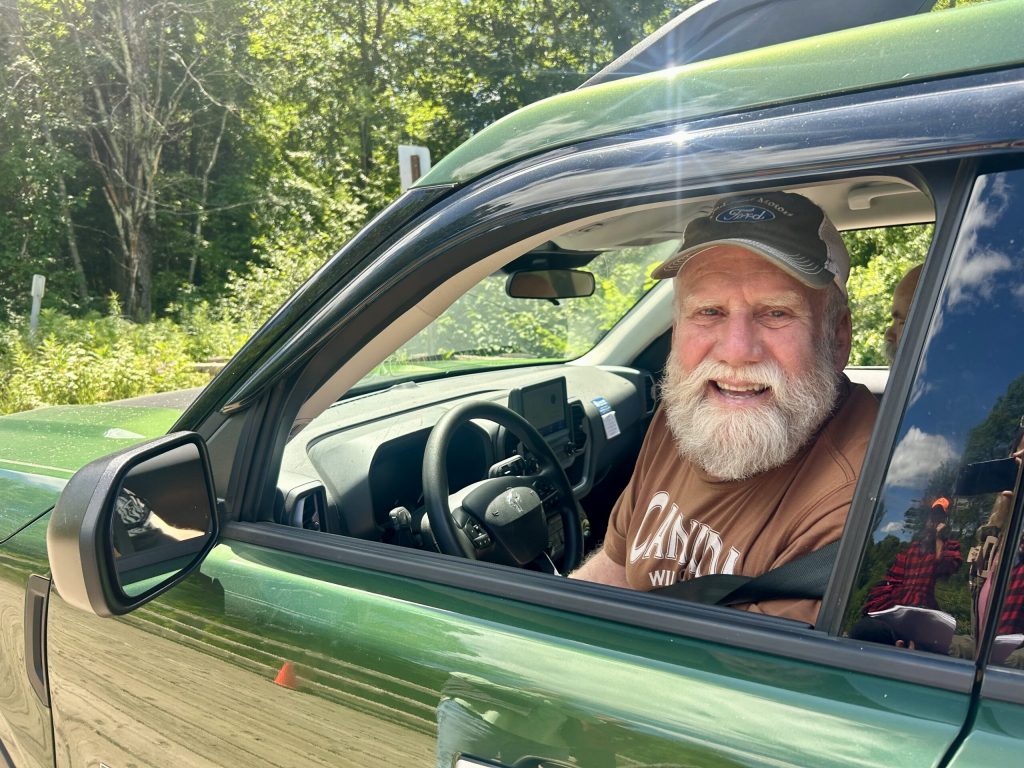
While out for a drive, Medford resident Jim Shaw stopped to talk to mining company officials near the site of its drilling activities in the Chequamegon-Nicolet National Forest on July 17, 2025. Danielle Kaeding/WPR
DNR addresses concerns about water
While drilling happens on a much smaller scale than potential new mines, some individuals have raised concerns about negative effects to the environment even from exploratory drilling. And some environmentalists say state oversight is too lax on the company, allowing it to depart from its approved plans or commit code violations by not lining pits or risking contamination by digging them at or below the groundwater table.
“They’re drilling and intercepting groundwater,” Reimann said.
Company officials say those claims are untrue. Images of an unlined sump circulated online, but Quigley said the company hadn’t yet used it for drilling.
Donohue also refuted claims the company struck groundwater. One pit showed standing water, which Donohue said was simply from recent rains. Molly Gardner, metallic mining coordinator for the Wisconsin Department of Natural Resources, said inspections showed the pit was dry when dug. She said heavy rains percolated into the soil and then drained into the pit.
“That’s rainwater and not groundwater,” Gardner said.
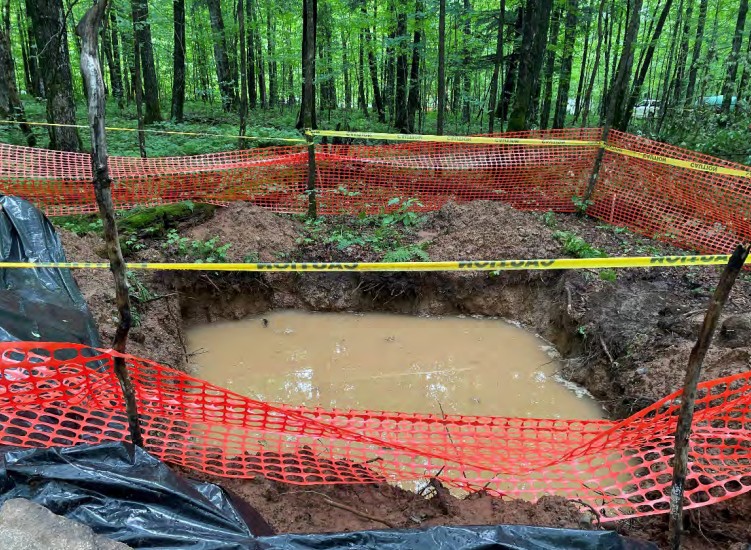
The Wisconsin DNR says standing water in a pit or sump was determined to be rainwater, not groundwater as some residents have feared. Screenshot from DNR inspection report
However, the company has encountered problems that have disrupted drilling and blocked holes. Last week, the Wisconsin DNR issued a notice of noncompliance to Green Light after a drill hole could not be abandoned in line with state regulations.
On July 25, steel casing that had been drilled into bedrock became disconnected 50 feet below the surface. Company officials said they believe rocks knocked the casing out of place when drill rods were removed from the hole. They filled the top 50 feet of the hole with cement, as well as the top of the casing left in place. But the rest of the hole remains unfilled up to 908 feet down.
The DNR’s Gardner said the steel casing that remains in place still serves as a barrier to protect groundwater, adding that nothing will be able to get down into the hole. Donohue said it’s “not ideal,” but does not pose risks to groundwater.
The DNR recommended that the company use a different drill bit to drill the remaining holes, and the agency isn’t requiring any further action or groundwater monitoring for the project. Even so, environmental and tribal advocates say it would be helpful to have additional data. Dave Blouin, mining committee chair with Sierra Club, said testing would help determine whether there’s any potential groundwater contamination from sulfide minerals. “Without testing, I guess we’re not going to know to what extent groundwater might have been harmed or contaminated, and it doesn’t look like DNR is going to do that,” Blouin said. “I would certainly encourage them to, but there’s no requirement that they do so.”
State Geologist Sue Swanson with the Wisconsin Geological and Natural History Survey said they’ve been conducting quarterly groundwater monitoring of six wells at the Bend site since late 2021 until fall of last year. The state has also monitored shallow water quality conditions in wetlands and the North Fork of the Yellow River.
“The quality of the water at the Bend site is similar to the high quality water that we see across the Chequamegon Nicolet-National Forest,” Swanson said.
However, Swanson said they discontinued monitoring after the Forest Service said it didn’t have enough money to support the work. The agency has since secured funds to support scaled-back groundwater monitoring that’s on track to resume later this fall through late 2027 or early 2028. Swanson said sampling will be done twice a year because they haven’t seen wide variations in water quality, and the data will help inform agency decisions at the site.
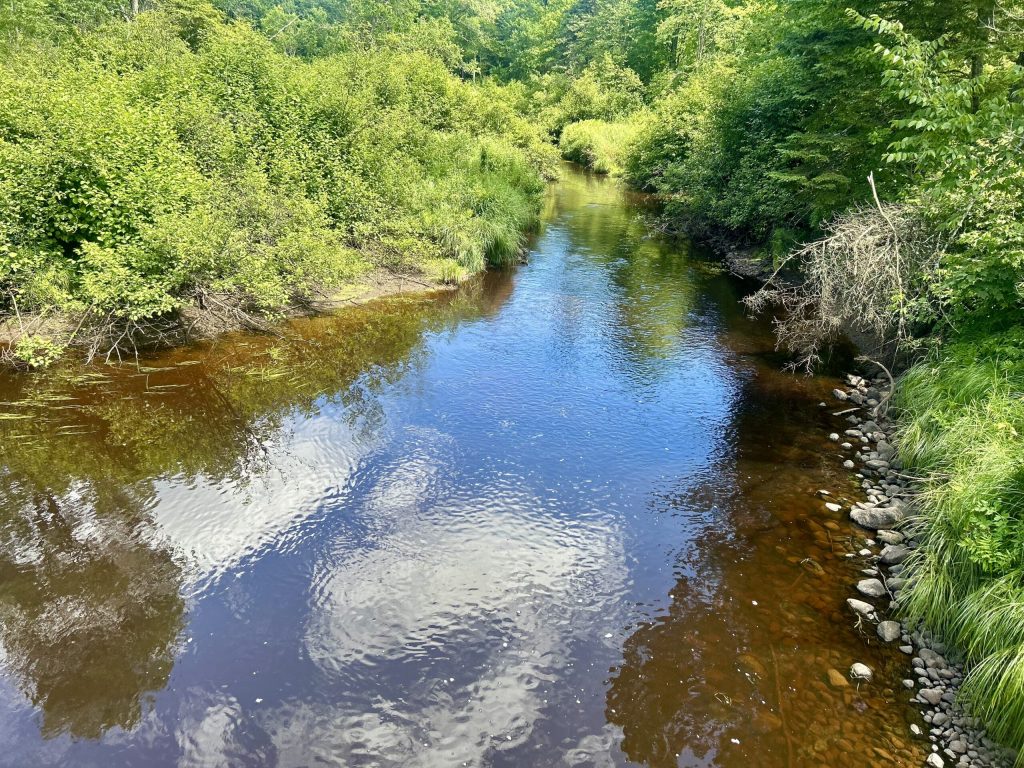
The North Fork of the Yellow River on July 17, 2025. It’s a source of water for Green Light Wisconsin’s drilling activities at the Bend deposit in the Chequamegon-Nicolet National Forest near Medford. Danielle Kaeding/WPR
Additional wetlands found on site
Throughout drilling, the DNR has monitored operations and inspected the site. On July 8, the agency identified five ephemeral wetlands within or near proposed access routes or drill sites that were previously unknown. Gardner said the company is using erosion control measures to prevent runoff from negatively affecting wetlands or the river.
Others aren’t as confident the company will prevent environmental harm.
John Coleman is the environmental section leader with the Great Lakes Indian Fish and Wildlife Commission. The agency represents the treaty rights of 11 tribes to hunt, fish and gather on lands outside their reservations in Michigan, Minnesota and Wisconsin. A GLIFWC staff member has been visiting the site once a week to ensure water protections are in place.
“The concern is that this be done in the most protective way possible, so there isn’t damage to natural or cultural resources,” Coleman said. “Ultimately, there’s concern that this would develop into a bigger project.”
Even so, the Lac du Flambeau Band of Lake Superior Chippewa had sued the DNR to bar the agency’s decision to grant a general construction site permit for drilling. The tribe argued the company should obtain an industrial permit because drilling could damage environmental, cultural and historic resources that include Indian trails and burial sites. A Taylor County judge denied the request.
Others have voiced concern about potential PFAS in drilling fluids. Gardner said the DNR reviewed ingredients and safety data sheets for its approved drilling fluids and found no evidence they contain the harmful chemicals.
On the company’s behalf, Donohue makes a broad claim: This drilling is safe.
“There is almost no risk that this drilling is going to have any kind of a negative impact on groundwater systems based on the techniques we’re using and the drill products that we’re using,” Donohue said.
The company expects drilling at the site to continue through August. It will then reclaim drill sites by backfilling the sumps and reseeding the area.
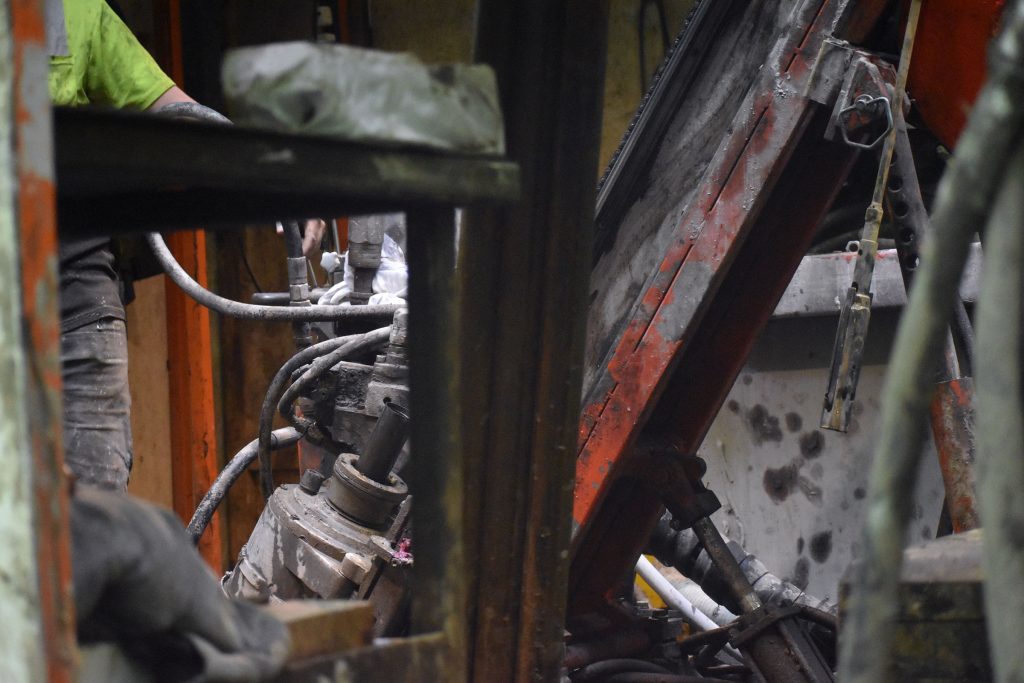
Crews are pumping cement down a drill hole as they work to seal the first two of six holes drilled at the Bend deposit in the Chequamegon-Nicolet National Forest on July 17, 2025. Danielle Kaeding/WPR
Groups call for environmental assessment for expanded drilling
While work continues, Green Light has also applied for a prospecting permit from the Bureau of Land Management to drill an additional 15 holes to explore federally owned land. The Forest Service is reviewing the project, and environmental groups are calling for an environmental assessment.
Federal agencies have been directed to speed up their permitting process under the National Environmental Policy Act in line Republican President Donald Trump’s executive order to unleash American energy.
The Forest Service had indicated it would conduct the environmental assessment, which is a more comprehensive review. Now the federal agency plans to issue a decision memo under a categorical exclusion, which is typically used when an agency determines a project won’t have a significant effect on the environment.
A spokesperson with the U.S. Department of Agriculture, which houses the Forest Service, said the agency is removing “burdensome Biden-era regulations that have stifled energy and mineral development.”
Sierra Club’s Blouin said the categorical exclusion process essentially rubber-stamps a permit.
“It quickens permitting, but we think it’s inadequate for protecting the sheer volume of natural resources deserving protection at the site,” Blouin said.
Blouin said several drill sites are located in wetlands, and the project would disturb threatened and sensitive species like the wood turtle and northern Goshawk.
Tribes are also concerned about effects that future drilling may have on old-growth trees, as well as the potential for wet conditions to cause rutting that may disturb cultural artifacts. Coleman noted a cultural site known as the Big and Little Indian Farms lies less than a mile away across the Yellow River, and wild rice beds lie downstream in the Chequamegon Waters Flowage.
With the discovery of additional wetlands, Coleman said the Forest Service should require any future drilling to occur on frozen ground to minimize impacts.
A USDA spokesperson said the Forest Service and Bureau of Land Management will decide the level of NEPA compliance required based on public input, tribal consultation and anticipated environmental effects. Donohue said company officials hope agencies will finish their review by October.
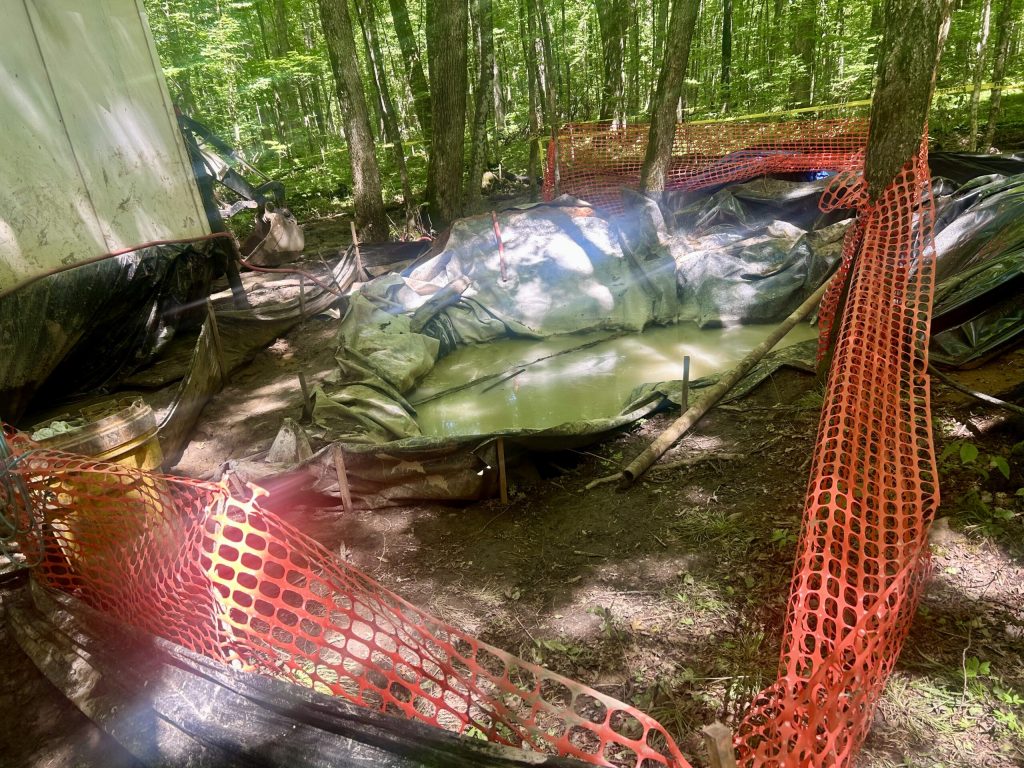
A pit covered by a plastic liner contains drilling, water fluids and cuttings from Green Light Wisconsin’s exploration of the Bend deposit in the Chequamegon-Nicolet National Forest on July 17, 2025. Danielle Kaeding/WPR
As exploration continues, any mine is still years away and uncertain
Over the next three or four years, Donohue said Green Light will be focused primarily on exploration.
If the company pursues a mine, the DNR’s Gardner said Green Light would have to undergo an extensive, multi-year study with regulators. The process would require an environmental impact statement, public input and numerous plans and related approvals.
Donohue has said it would likely take another four years to go through the state’s permitting process. In the meantime, the company’s vision is to prove it can mine metals like copper and gold in northern Wisconsin and to build a regional mill operation that would serve several mines.
“We firmly believe that with the proper application of engineering and science that a mining operation can be designed to be protective of the environment and provide good economic benefits, in this case, to the northern part of Wisconsin, and bolster our national security,” Donohue said.
Even if a mine is developed a decade from now, Blouin argued that the small amount of copper at the Bend deposit is unlikely to make a dent in domestic supply of minerals deemed critical for national security and domestic energy production.
“It’s in an environmentally sensitive place,” Blouin said. “Northern Wisconsin is a very wet environment, and it’s a troublesome, problematic environment within which to conduct metallic sulfide mining.”
A mining company is drilling for metals in Wisconsin. Opponents are on edge. was originally published by Wisconsin Public Radio.
If you think stories like this are important, become a member of Urban Milwaukee and help support real, independent journalism. Plus you get some cool added benefits.

















